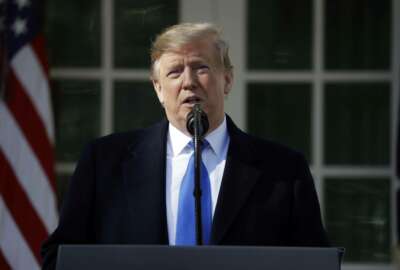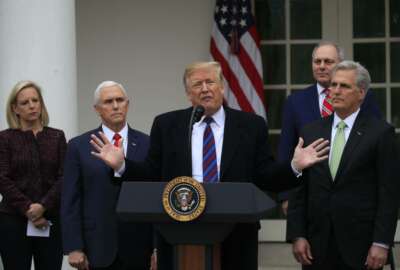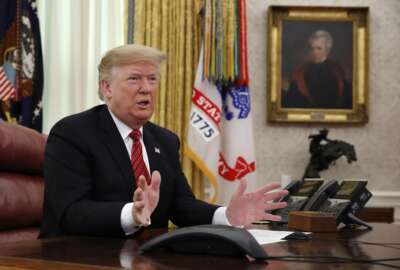
Trump at last makes 2019 federal pay raise official
President Donald Trump has signed an executive order that makes the 1.9 percent federal pay raise for civilian employees official.
This story was updated on Thursday, March 28 at 9:30 p.m. to reflect additional memos and information from the Office of Personnel Management.
Best listening experience is on Chrome, Firefox or Safari. Subscribe to Federal Drive’s daily audio interviews on Apple Podcasts or PodcastOne.
After employees had anxiously awaited for more than a month for a bump in their paychecks, President Donald Trump on Thursday made the 1.9 percent federal pay raise official.
The executive order, which the President signed Thursday, authorized an average, across-the-board raise of 1.4 percent, with an additional 0.5 percent adjusted in locality pay rates.
The raise is retroactive to the first pay period in 2019, which for most civilian employees would have began on Jan. 6.
In total, civilian employees will receive an average 1.9 percent raise. A 1.4 percent raise applies to the vice president, members of the Senior Executive Service and GS-15s who have reached the Executive Schedule ceiling and had previously experienced several years of pay freezes.
Some political appointees will get an increase of up to 1.9 percent in the preexisting payable rates, which had been frozen since 2014, according to a memo from Margaret Weichert, acting director of the Office of Personnel Management and deputy director for the Office of Management and Budget.
The EO rescinds the order Trump signed back in December, which froze pay for civilian employees at 2018 levels.
The 1.9 percent raise was part of the spending package that Congress passed and the President signed into law back on Feb. 15.
Federal employees have been waiting and asking for updates on the status of the raise since then. Weichert said last week she understood federal employees were frustrated with the wait. She added that the lengthy legal exercise the administration had to complete in order to finalize the federal pay raise demonstrated a clear need to modernize the pay system altogether.
It’s still unclear when exactly employees will see these raises — along with a lump sum to reflect the retroactive pay they’ve earned as of the beginning of the year — in their paychecks. Most federal employees were last paid on or near March 22 at 2018 levels. The current pay period for most civilian employees ends Friday, March 30, with checks due on or around April 5.
A series of OPM memos posted Thursday night did not detail when exactly federal employees would see raises reflected in their paychecks.
The President also approved new locality pay rates for 2019, which OPM has detailed in a series of new memos.
You can find OPM’s full list of updated 2019 pay tables here. A consolidated list of adjustments for all locality pay areas and total raises can be found here.
In addition, OPM described a variety of scenarios for employees who separated or left federal service after the first pay period of 2019 but before the retroactive raise was made official. Details for those scenarios can be found here.
Employees are not entitled to any interest on retroactive payments, OPM said the memo.
To be clear, the 1.9 percent raise is an average. Federal employees in certain locality pay areas will receive more than the average, while others will receive less.
Employees in the Washington, D.C-Baltimore, Maryland, locality pay area will see increases totaling 2.27 percent. Employees in the “rest of U.S.” will receive a total increase of 1.66 percent.
Some 72,000 federal employees in the six new locality pay areas that the President approved late last year should see a slight difference now in their pay adjustments. The administration had added Birmingham, Alabama; Burlington, Vermont; Corpus Christi, Texas; Omaha, Nebraska; San Antonio, Texas; and Virginia Beach/Norfolk, Virginia, as separate locality pay areas for the first time back in December, but with rates frozen at 2018 levels, employees in those locations subsequently had their pay locked in at “rest of U.S.” rates.
Now, employees in these six new locality pay areas will see the following locality payments, as opposed to the 15.37 percent they received under their previous “rest of U.S.” designation.
Employees in these six new locality areas hoping for big pay boosts may be disappointed. While federal workers in these areas ultimately secured higher raises than they did in 2018, the rising number of distinct locality pay areas may be to blame.
“When locality pay percentages are adjusted, the practice has been to allocate a percent of the total GS payroll for locality pay raises and to have the overall cost for such pay raises be the same, regardless of the number of locality pay areas,” OPM wrote in December in the final rule announcing the addition of the six new areas.
Last year’s rulemaking brings the total number of locality pay areas separate from the “rest of U.S.” to 52.
The 2019 pay raise is the first time in several years that Congress has acted to override the President’s plans for federal pay. Trump originally chose to freeze pay this year for civilian employees at 2018 levels.
Momentum to provide civilian employees a 2.6 percent increase this year picked up after the longest government shutdown in U.S. history ended in late January, with legislation authorizing the raise scoring bipartisan support in both the House and Senate.
A 1.9 percent pay raise, however, ultimately gained the most consensus, with federal employees earning an increase of equal amount back in 2018.
Members of the military are receiving a 2.6 percent pay raise in 2019.
Some members of Congress are already thinking about federal pay in 2020, as Rep. Gerry Connolly (D-Va.) and Sen. Brian Schatz (D-Hawaii) introduced legislation that would grant federal employees a 3.6 percent raise next year.
Copyright © 2025 Federal News Network. All rights reserved. This website is not intended for users located within the European Economic Area.
Nicole Ogrysko is a reporter for Federal News Network focusing on the federal workforce and federal pay and benefits.
Follow @nogryskoWFED
Related Stories






